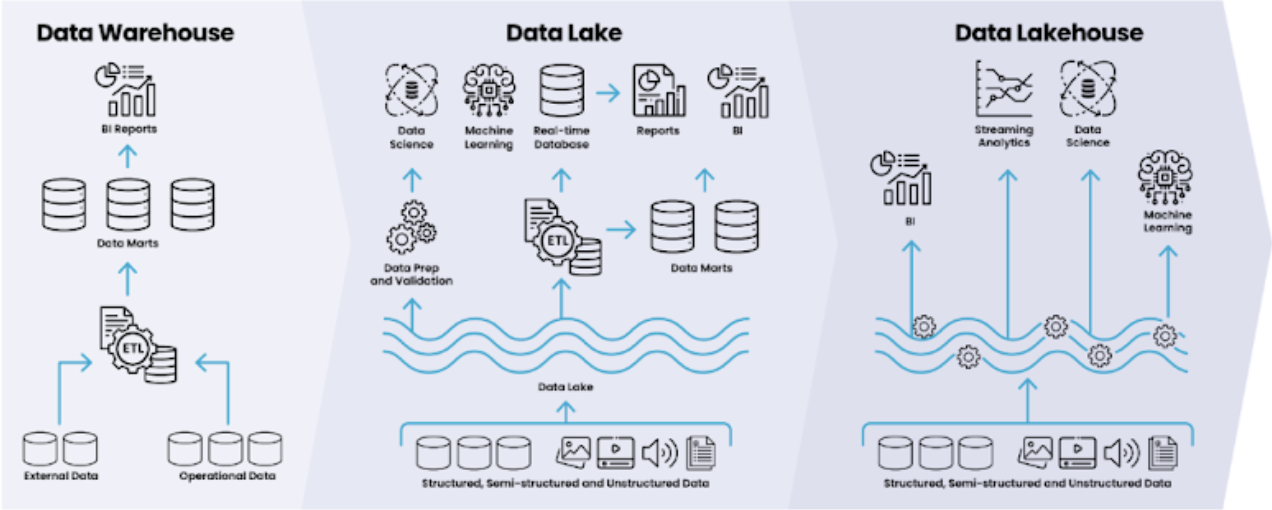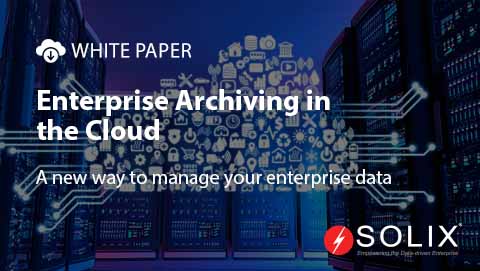Data Lakehouse
What is a Data Lakehouse?
Data Lakehouse is a modern data architecture that combines the flexibility of data lakes and the structure and querying capabilities of a data warehouse. Like Data Lakes, it allows large volumes of data to be stored in its raw format. As the data flows through the architecture, the quality of data is progressively improved till it is ready to be used by downstream applications.

Why Data Lakehouses?
First-generation data warehouses and data lakes, while foundational, lacked key capabilities that defines modern AI and data analytics. These limitations can be grouped into three main areas:
- Data Variety: Traditional data warehouses focused on structured data and lacked schema flexibility. This limited their ability to handle the massive volume of unstructured data critical for AI applications like image recognition and sentiment analysis. Data lakes could store all data types, but lacked the structure and organization needed for efficient analysis.
- Data Processing Speed and Agility: First-generation data warehouses often relied on heavy ETL jobs to ingest data. This was slow and inflexible for AI operations as data exploration and model-training needed a continuous flow of data. Similarly, while data lakes were scalable, they often resulted in “data swamps” as the raw data remained unusable due to the lack of adequate data governance.
- Limited analytics capabilities: Traditional data warehouses excelled in producing defined reports and BI. It struggled with complex calculations and algorithms required for AI and advanced analytics systems. Data lakes, on their own, lacked the built-in analytical tools for data mining and model serving.
These critical challenges eventually led to the development and adoption of data lakehouses as a unified platform for AI, model serving, advanced analytics and BI applications in the enterprise.
Key Benefits
Data Lakehouses offer a range of benefits, making them an attractive option for organizations looking to leverage their data effectively. Here are some key advantages:
- Reduced Costs: You can ditch multiple data silos and tools, streamlining your data architecture and saving on hardware, software, and personnel costs.
- Efficient storage: Data Lakehouses store data in its native format, eliminating the need for expensive data transformations and optimizing storage utilization.
- Scalability: They easily scale to accommodate expanding data volumes without significant infrastructure investments.
- Faster data access: All your data resides in one place, enabling quicker querying and analysis for informed decision-making.
- Simplified workflows: The unified platform eliminates the need to switch between different tools for different data types, streamlining workflows and boosting efficiency.
- Real-time insights: Some data lakehouses support real-time data processing, allowing you to react instantly to changing market conditions or customer behavior.
- Democratization of data: More users across various departments can access and analyze data, fostering experimentation and discovery.
- Improved data governance: Data lakehouses provide capabilities for data quality checks, schema enforcement, and access control, ensuring data integrity and compliance.
- Openness and accessibility: Data lakehouses support open table and open file formats in the enterprise. This makes managing large data sets easier while enhancing accessibility, while improving data governance capabilities within the platform.
In conclusion, Data Lakehouses offer a compelling solution for organizations seeking to harness the power of their data for advanced analytics, AI, and business intelligence. By combining the strengths of data lakes and data warehouses, data lakehouses address the limitations of earlier data architectures, enabling efficient storage, processing, and analysis of all data types at scale. With reduced costs, faster access, improved data governance, and open data formats, data lakehouses are poised to be a cornerstone of modern data-driven organizations.
FAQs
What are the limitations of Data Warehouses and Data Lakes?
Data Warehouses:
- Limited data types: Primarily handle structured data, making them unsuitable for unstructured and semi-structured data like sensor readings or social media posts.
- Slower querying for raw data: Extensive data transformation can slow down queries on raw data.
Data Lakes:
- Slower analysis: Lack of schema and data organization can lead to slower querying and analysis.
- Data governance challenges: Unstructured data makes it difficult to ensure data quality and compliance.
How does a Data Lakehouse address these limitations?
Data lakehouses combine the strengths of both worlds:
- Stores data in native formats: Like data lakes, they can store data in various formats without expensive transformations.
- Supports schema enforcement: Allows for defining structure and organization for better data quality and faster querying like data warehouses.
Who can benefit from Data Lakehouses?
Any organization that deals with a variety of data types and wants to leverage it for advanced analytics, machine learning, or business intelligence can benefit from data lakehouses.
What are some considerations before implementing a Data Lakehouse?
Data Architects might need to consider the following points before implementing a data lakehouse
- Data migration strategy: Plan how to migrate existing data from warehouses and lakes to the new platform.
- Security and access controls: Establish clear guidelines for data access and governance within the organization.
- Choosing the right tools and technologies: Select a data lakehouse solution that integrates well with your existing data ecosystem and offers the functionalities you need.





